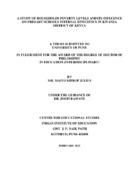| dc.description.abstract | Education is widely accepted as the main backbone of growth and development of
individuals and the nation. However, its achievement continues to elude many who are poverty
stricken. Government of Kenya introduced free primary education in 2003 and tuition free
secondary education in 2008. It is estimated that about 3 millions children are not enrolled in
primary schools. For the children who enrolled in grade one, only between 46-48% can manage
to complete the final grade and transition rate remained below 50%. The study was envisaged to
look at households’ poverty levels and its influence in internal efficiency of primary schools in
Kwanza district of Kenya. The objective of the study was to: determine the poverty levels of the
selected households, ascertain the internal efficiency of primary schools and to establish
relationship between the households poverty levels and schools internal efficiency.
The study used the theory of production function developed by Von Thunen 1826. The
study adopted an integrated interdisciplinary approach to investigate the research problem.
Descriptive research method was employed. The study used survey research design. The sample
size of the study was 468 respondents’, comprising of 360 household heads, 12 head teachers
and 96 class teachers. Simple random and purposive sampling design was used. Four instruments
were developed and used to collect data: Questionnaires for the households’ heads and class
teachers, school data form and interviews.
Data was analyzed with the help of SPSS computer programme (11.5). Household
poverty levels were determined by use of poverty indexes developed by Greer and Thorbecke
(1986). National poverty line of Ksh 1562 developed by the government of Kenya in 2005/06
was adopted. Schools internal efficiency was determine with the help of educational statistical
indicators developed by UNESCO (2009). Further to establish the relationship and test the
hypotheses statistically, Pearson product moment correlation test was adopted. Findings of the
study were presented by use of tables and figures.
The study revealed that Kwanza district had 43.3 % of the households living above the
poverty line, and 56.7 % of them operating below the poverty line. In the period 2004-2009 the
dropout rate in Kwanza district schools ranged between 6.3% to 25.6%. While in the year (2010)
the district average dropout range between 4.5% to 24.3%. Further the findings revealed that
Kwanza district on average had a transition rate of 44.62% between the period 2002-2009, which
implied that about 55.38% pupils on the final grade in the district did not preceded for their
secondary education. The study also revealed that household’s poverty level had a significant
relationship with majority of the school internal efficiency measures which included repetition,
dropout, survival rate, cohort wastage, academic achievement and transition rate.
The study implications among others were that the ministry of education should establish
indicators for monitoring, evaluation and assessment of progress made in achieving educational
goals. The focus should include monitoring of inputs and outputs of school education to assess
their efficiency and effectiveness. The government should take the key responsibility of
preparing data base of the poor families in the district and develop a credit cum-subsidy scheme
that will provide financial support in terms of loans to the disadvantage group. | en_US |

